Physical Address
304 North Cardinal St.
Dorchester Center, MA 02124
To paraphrase Hans Zinsser, the prolific bacteriologist and epidemiologist: No matter how clean and regulated our society becomes, bacteria, viruses, and protozoa will always lurk in the shadows, ready to pounce when neglect, poverty, or famine weakens one’s defenses.
Hippocrates’ principles for the treatment of hand infections are fundamentally valid today. Wounds were kept clean with frequent changes of wine-soaked dressings. Dressings were kept loose “so as not to intercept the pus, but to allow it to flow away freely.” Coupled with these early principles is the pioneering work of Dr. Alan Kanavel, a Chicago general surgeon who treated hand infections in the preantibiotic era. Much of our current understanding of the pathogenesis and treatment of hand infections must be credited to his extensive dissections and innovative injection studies. Through these studies, he demonstrated the potential spaces of the hand and the pathogenesis of infection. From this data, he developed the surgical principles that remain the cornerstone of modern treatment of hand infections.
Hand infections can result in severe disabilities, including stiffness, contracture, and amputation. These complications have been substantially reduced through the introduction of antibiotic therapy in conjunction with surgical treatment. Although antibiotics have dramatically reduced the morbidity associated with hand infections, their use does not supplant the need for expedient and proper surgical intervention. Several factors influence the outcome of hand infections. These include the location of the infection, infecting organism, timing of treatment, adequacy of surgical drainage, efficacy of antibiotics, and health status and immunocompetence of the host. In the words of one of the preeminent U.S. public health officials, Dr. Charles V. Chapin: “As it takes two to quarrel, so it takes two to make a disease, the microbe and the host.”
Host factors play a determining role in the severity and duration of infection. Many medical conditions reduce host defenses. Malnutrition, alcoholism, autoimmune diseases, chronic corticosteroid use, hepatitis, and human immunodeficiency virus (HIV) infection are some of the comorbidities to be considered. The most prevalent disease associated with immunosuppression is diabetes mellitus, which affects approximately 10% of the adult population of the United States. ,
Early and superficial infections may respond to nonsurgical management. However, most acute infections of the hand represent surgical emergencies. Swelling and edema associated with an infection result in increased tissue pressure and can cause ischemia and tissue necrosis by a process resembling compartment syndrome. Furthermore, toxins produced by the offending pathogen can cause vascular thrombosis and tissue death. Patients with necrotizing fasciitis and gas gangrene need immediate surgical care.
Cellulitis is an infection of the subcutaneous tissue, which is often diffuse and can be associated with lymphangitis. It is caused by a single organism, usually Staphylococcus aureus or β-hemolytic Streptococcus. Lymphangitic streaking is more commonly seen with β-hemolytic streptococcal infections. It generally has a more distal nidus and spreads in a proximal direction. Cellulitis is a non–pus-forming infection and as such is initially treated nonsurgically. If the cellulitis is not responding to intravenous therapy over 12 to 24 hours, this often suggests the formation of pus (abscess) and more serious infection. Even in the absence of abscess formation, cellulitis associated with substantial swelling may require surgical decompression (e.g., necrotizing fasciitis). Cellulitis often requires hospital admission and close monitoring to assess the response to antibiotic therapy. A specific type of staphylococcal infection is the staphylococcal scalded skin syndrome, primarily a disease of young children that results from an exfoliative toxin-producing staphylococcal organism. , A high index of suspicion and early differentiation of this process from other skin conditions are important to treatment outcome. Although this syndrome is extremely rare in adults, it is associated with a high mortality rate, usually because of serious underlying illness, such as kidney failure or immunosuppression. Detection of the exfoliative toxin is required for diagnosis. Immunologic methods allow for more rapid detection. Prompt antibiotic therapy and local wound care are the mainstays of management. Both staphylococcus species and streptococcal species can produce toxins that can cause shock and multiorgan system failure. Streptococcus pyogenes, group A Streptococcus (GAS), can cause sepsis, shock, and rapid demise. Necrotizing fasciitis is a serious life-threatening infection that may initially resemble cellulitis. Although purulence is not present, a watery discharge often described as “dishwater-like fluid” may be seen superficial to the fascia. Most other hand infections are generally pus forming and are discussed in detail throughout the chapter.
The most common infecting organisms are Staphylococcus and Streptococcus species, with staphylococcal organisms predominating. Many infections, especially those associated with bite wounds, those associated with gross contamination, or those seen in diabetic patients, are often polymicrobial infections. Pasteurella multocida should be considered in most animal bites, and both streptococcal species and Eikenella corrodens should be considered in human bite wounds. Anaerobic infection is less common but should be considered in diabetic patients or intravenous drug users. Empirical antibiotic therapy should be tailored toward the most likely offending pathogen. The local prevalence of antibiotic-resistant organisms should be considered when starting empirical treatment. An infectious disease specialist familiar with the hospital-specific patterns of antibiotic resistance can be invaluable in directing antibiotic therapy and in managing outpatient intravenous therapy.
The increasing incidence of infection with methicillin-resistant S. aureus (MRSA) has been recognized throughout the surgical and infectious disease literature. A strain of S. aureus resistant to methicillin was mentioned in reports from the United Kingdom in 1961. This strain was soon identified worldwide and was associated with hospital-acquired infections (HA-MRSA). Only a handful of successful HA-MRSA clones are responsible for the majority of infections, and different clones dominate in different geographic locations. However, MRSA infections have been increasingly identified as community-acquired infections (CA-MRSA). There are unique microbiologic and genetic properties distinguishing the hospital-acquired and community-acquired strains. A community-acquired infection is defined as occurring in patients with MRSA identified by culture who have no history of a hospital or medical facility stay within the past year, who have no history of dialysis or surgery occurring within the past year, and in whom no indwelling catheters are present.
CA-MRSA is now the predominant strain in hand infections, found in up to 40% to 60% of S. aureus infections. The majority of CA-MRSA infections in the United States have been caused by a single clone (USA300). One of the distinguishing features in CA-MRSA is the frequent gene sequence encoding for Panton-Valentine leukocidin (PVL), a potent toxin that leads to the characteristic tissue necrosis commonly seen in the clinical setting. Of recent concern is the increased incidence of multidrug-resistant MRSA, with resistance to clindamycin and levofloxacin. Kistler et al. reported on the patient factors associated with specific drug resistance. Risk factors for clindamycin resistance included nosocomial infections, a history of intravenous drug use, and hepatitis C. Risk factors for levofloxacin resistance included a history of diabetes and a fever upon initial presentation. , ,
MRSA infections frequently have a characteristic appearance of a dermonecrotic skin lesion ( Fig. 2.1 ). They are often mislabeled by patients as “spider bites” due to their appearance. Recently, we have not seen the extensive tissue necrosis with MRSA infections that we have in the past. Empirical treatment of hand infections has also changed to address potential MRSA infections. , , , Successful treatment requires surgical debridement with excision of necrotic tissue in conjunction with appropriate antibiotic therapy.
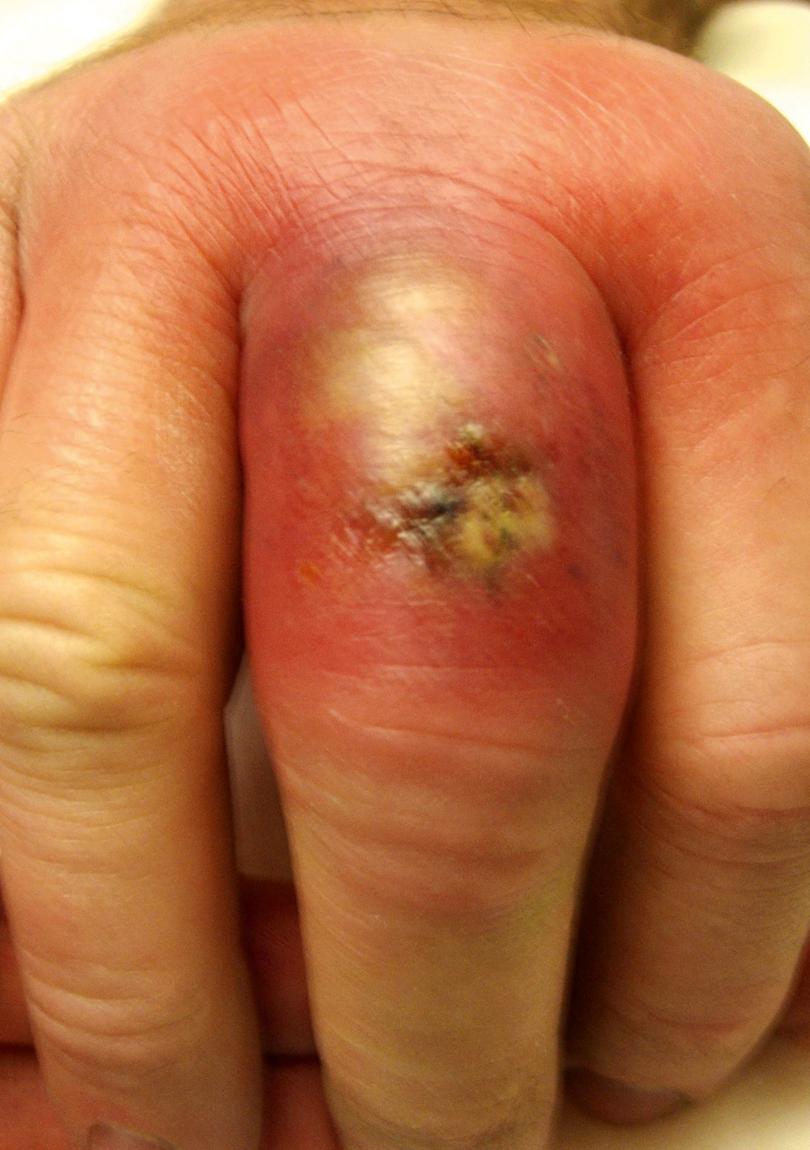
The hand is a very well-vascularized region, making it less vulnerable to postoperative infection than other anatomic sites, with an incidence of deep postoperative infection of less than 1%. S. aureus is the most common pathogen in clean surgical procedures. The use of perioperative intravenous antibiotics within 1 hour preceding surgery has greatly reduced the incidence of postsurgical infections in general orthopedic practice. The benefit of perioperative intravenous antibiotics in the total joint population was generalized to all orthopedic procedures, leading to antibiotic overuse for clean soft tissue procedures. In particular, the use of perioperative antibiotics in elective hand surgery has been overused despite strong support that it does not decrease the incidence of surgical site infections in elective soft tissue procedures of the hand. , The use of antibiotics may be related in part to institutional policies rather than to surgeon preference. Ultimately, the whole patient and any underlying comorbidities must be considered. Prophylactic antibiotics in patients with joint arthroplasties have been recommended to protect the prosthesis more than to prevent surgical site infection, although one recent study has demonstrated no difference in prosthetic joint infection with or without prophylactic antibiotic therapy. Patients with an altered immune response may have a potentially greater benefit from prophylactic antibiotics than an immunocompetent host. For surgical procedures that involve exposure of the bone or joint or those involving implants, we routinely administer intravenous prophylaxis.
Surgical site preparation has transitioned predominantly to the use of prep sticks to clean the surgical site. Recent studies suggest that the use of DuraPrep and Betadine were better than ChloraPrep for skin decontamination in the hand, with the majority of pre and post-prep colonies consisting of Bacillus species. Beredjiklian and colleagues showed a five times greater area of unprepped skin surface when comparing a prep stick to soaked 4 × 4 gauze sponges. However, both methods demonstrated <1% unprepped skin surface area. Given the low rate of infection following clean surgery of the hand, the clinical implications remain unknown.
Clinical examination remains the hallmark of diagnosis in hand infections. Pain (dolor) and increased temperature (calor), with or without erythema (rubor), and tenderness remain the prime features of hand infection. Temperature elevation is inconsistent. Abnormalities of the white blood cell (WBC) count and C-reactive protein (CRP) level are uncommon features of a hand infection. In one study, these lab values were normal in 75% of patients. The erythrocyte sedimentation rate (ESR) was slightly more useful, with elevation of the ESR found in 50% of patients.
The initial evaluation and management in the emergency department should include a thorough medical history, assessment of risk factors for immunocompromise, and evaluation of tetanus immunization status. Appropriate tetanus prophylaxis should be administered based on immunization history and time of the last booster shot. Tetanus immune globulin (TIG; HyperTET®) and tetanus toxoid booster are given if the patient has not had a series of tetanus immunizations. Clinical evaluation of the affected extremity should include examination for fluctuance, warmth, edema, redness, tenderness, and lymphangitis or lymphadenopathy. Areas of cellulitis should be marked on the skin so that progression or regression of the infectious process can be monitored. If an open draining wound is present, a specimen should be sent for aerobic and anaerobic culture. Radiographs are obtained to evaluate for the presence of a foreign body, gas within the soft tissues, underlying fracture, septic joint, or osteomyelitis ( Fig. 2.2 ). Blood cultures should be drawn in febrile patients. Blood should be assessed for a complete blood count (CBC), ESR, CRP, electrolytes, and blood glucose measurements. Hand infection may be the first presenting complaint of undiagnosed diabetes. Laboratory evaluation is important in both the initial assessment of a patient and the ongoing monitoring of the infectious or inflammatory process. The acute phase reactants are nonspecific markers of inflammation, produced in response to noxious stimuli, which can include infection, noninfectious inflammation, or trauma. CRP levels start to increase between 4 and 6 hours after a stimulus. CRP levels peak between 36 and 50 hours and levels can increase 100- to 1000-fold during acute inflammation. Its half-life is consistent, which makes it a valuable tool for monitoring the progress of an infection. Procalcitonin is an acute phase reactant produced in extrahepatic tissue. An elevation in procalcitonin can be seen as early as 3 hours after the onset of an inflammatory condition. It has been most commonly described in the diagnosis of respiratory infections. Its specificity and early detection may make it a more commonly used marker of inflammatory and infectious conditions in the future. The ESR is an indirect measure of inflammation and starts to rise later in the disease process, typically between 24 and 48 hours. It changes more slowly and is less useful for monitoring day-to-day progress, but it is very useful in monitoring longer time frame response to treatment. In addition to the WBC count, platelets are an acute phase reactant, increased by inflammatory or infectious conditions, and may be a marker of disease progression.
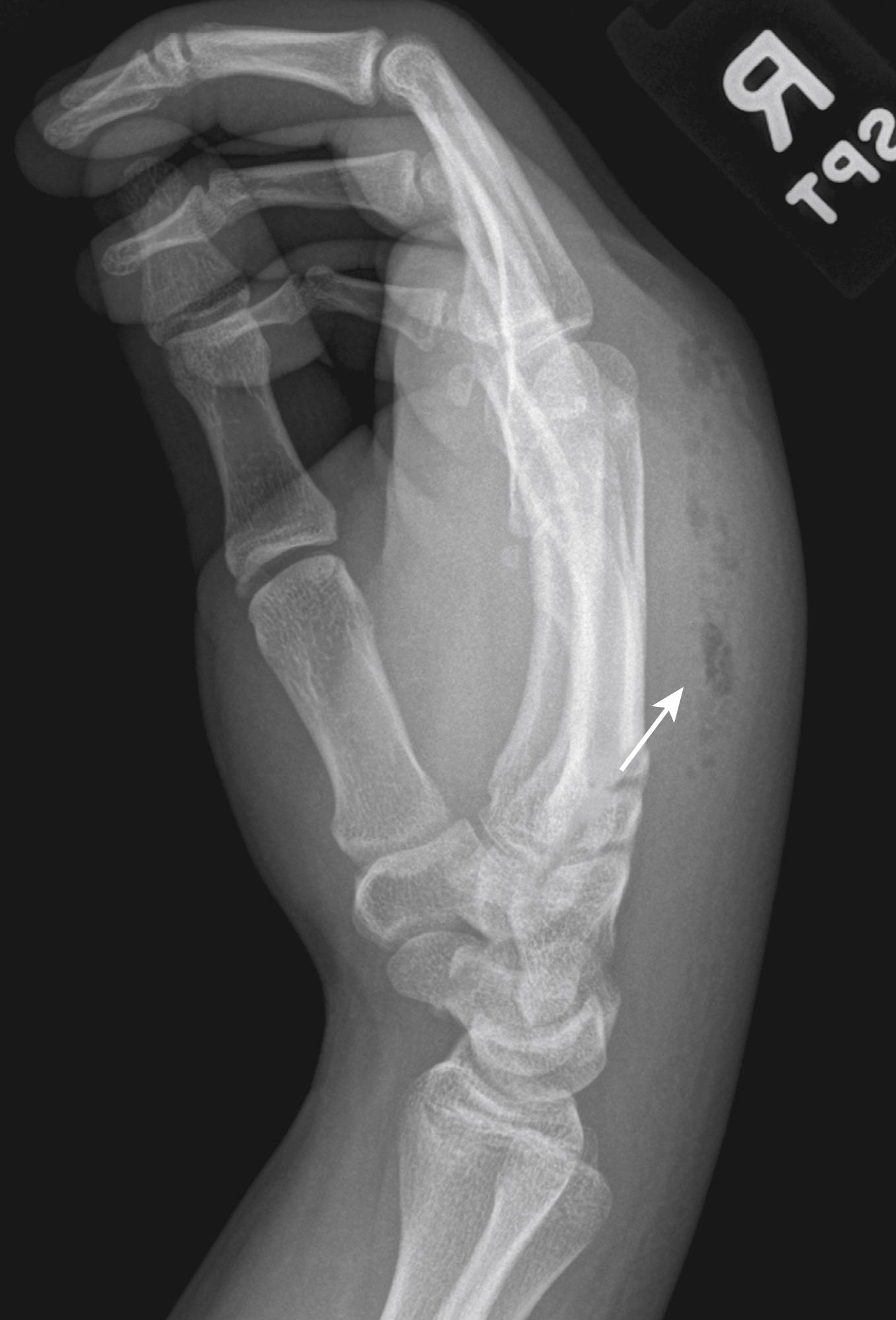
When a patient presents with an area of fluctuance, this should be provisionally treated with aspiration or bedside decompression until formal surgical debridement is performed. The fluid should be sent for culture. For patients who do not clearly have an abscess, aspiration may be useful to identify a deep pyogenic infection. Magnetic resonance imaging (MRI), if readily obtainable, can be used to identify areas of fluid collection in the deep spaces of the hand or along tendon sheaths. A computed tomography (CT) scan can also identify a fluid collection if an MRI cannot be obtained or is contraindicated. Swollen painful joints should be aspirated with caution. The site of aspiration should not be over an area of cellulitis to avoid seeding the joint with bacteria. The aspirated fluid should be sent for culture. Joint fluid analysis with cell count, glucose, and protein levels can be obtained if an adequate aspirate is obtained. If the joint aspirate is not clearly pyogenic and indicators of infection are absent, antibiotics are withheld until cultures are available. Nonsteroidal antiinflammatory drugs (NSAIDs) may be given to both treat the patient and help distinguish between an inflammatory process and sepsis. If the presentation is suggestive of an inflammatory process, antibiotics are withheld while the response to NSAIDs is observed. When infection is suggested, empirical antibiotic therapy should be started in the emergency department after a culture specimen has been obtained.
Differentiating between an infectious process and an inflammatory process, especially pseudogout, can be difficult. The differential diagnosis requires consideration of many factors, including the patient’s history, the presence of underlying diseases, and the clinical presentation ( Case Study 2.1 ). When to withhold antibiotic therapy can be a diagnostic challenge. The use of antibiotics in some circumstances may treat the physician’s anxiety more than the patient’s disease. Overnight hospital observation while antibiotics are withheld allows the disease process to be closely monitored and provides the opportunity to change the treatment regimen if the anticipated improvement is not evident with NSAID therapy. When the level of suspicion for an infectious process is low, a corticosteroid dose pack may be used. The patient is reevaluated in 24 to 48 hours. The importance of seeing the patient again within 24 to 48 hours cannot be overstated. If the process is noninfectious, the symptoms will be nearly resolved. It may take years to develop the clinical experience to recognize these different processes, and even the experienced eye can mistake an infectious process from an inflammatory process and vice versa. FLOAT NOT FOUND
An 89-year-old man with a 6-month history of wrist pain and swelling presented to the emergency department with a 2-day history of acute exacerbation of his pain. His clinical examination demonstrated swelling and tenderness about the wrist with markedly restricted motion of the wrist and fingers. Radiographs demonstrated calcification of the triangulofibrocartilage complex ( eFigs. 2.1 to 2.3 ). Laboratory analysis demonstrated normal uric acid, elevated WBC (13.8), elevated ESR (38), and elevated CRP (201). Hospital observation and surgical intervention were declined by the patient, and further follow-up in orthopedics was also declined. Subsequent chart review was notable for return to asymptomatic condition in the absence of antibiotic therapy or surgery. Sometimes patients know best.
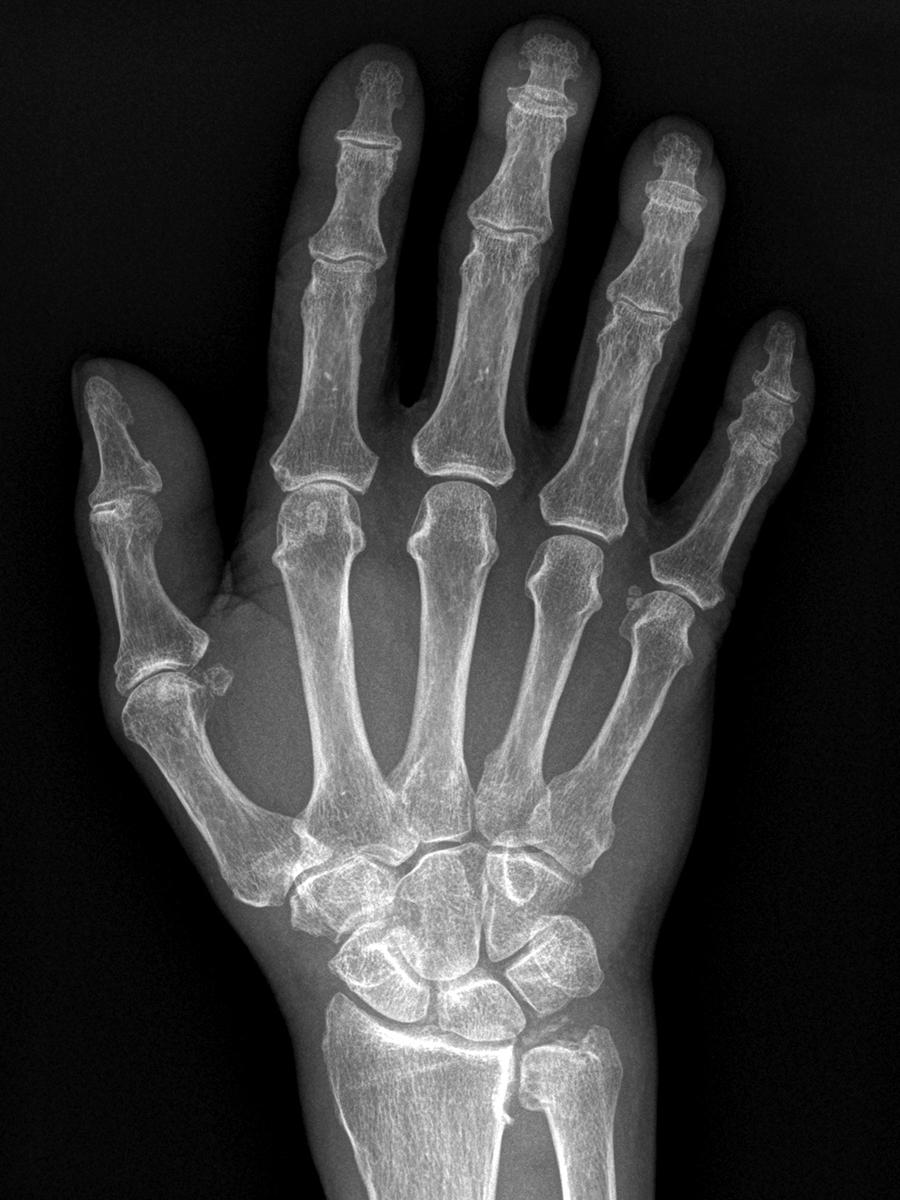
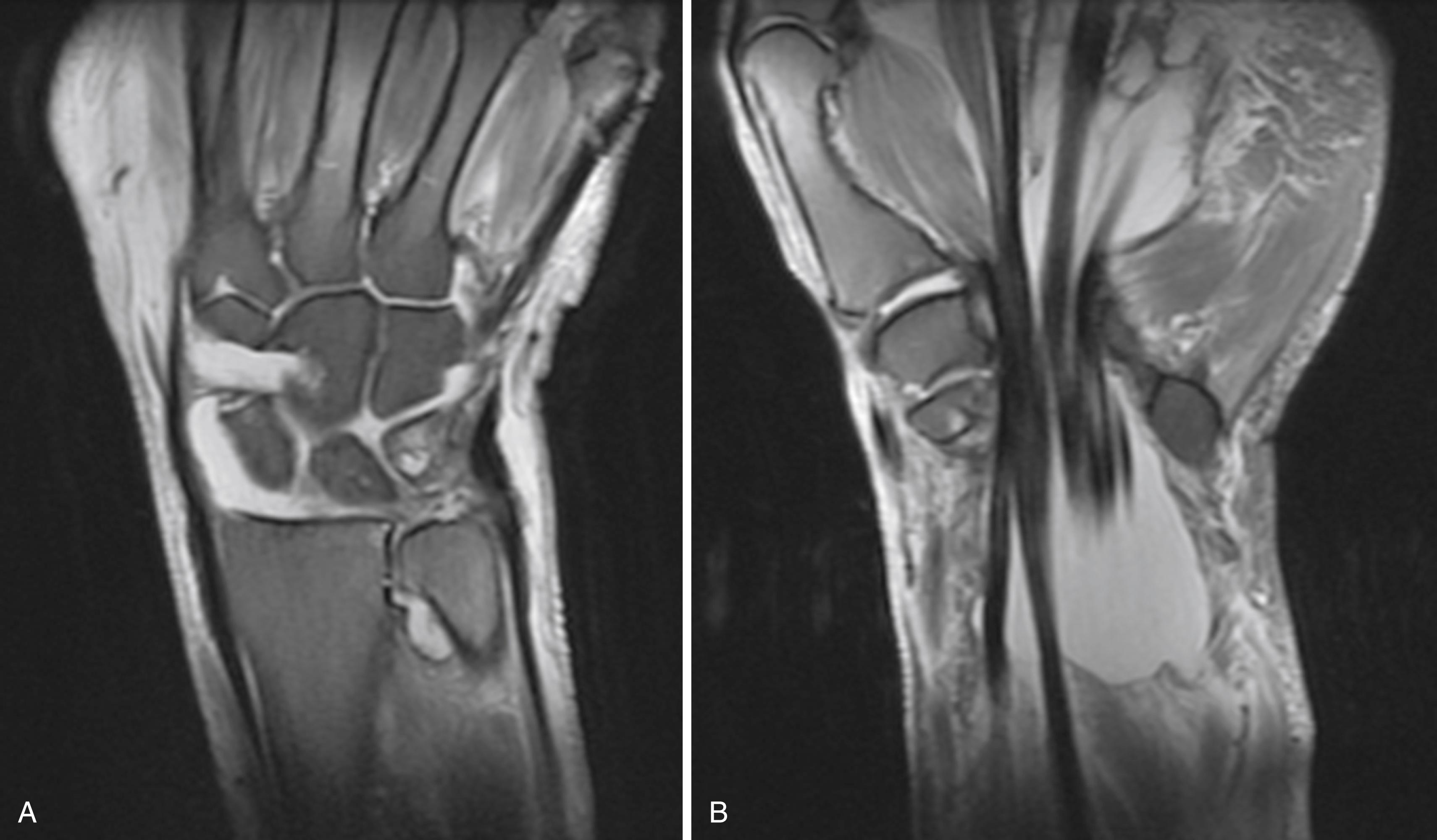
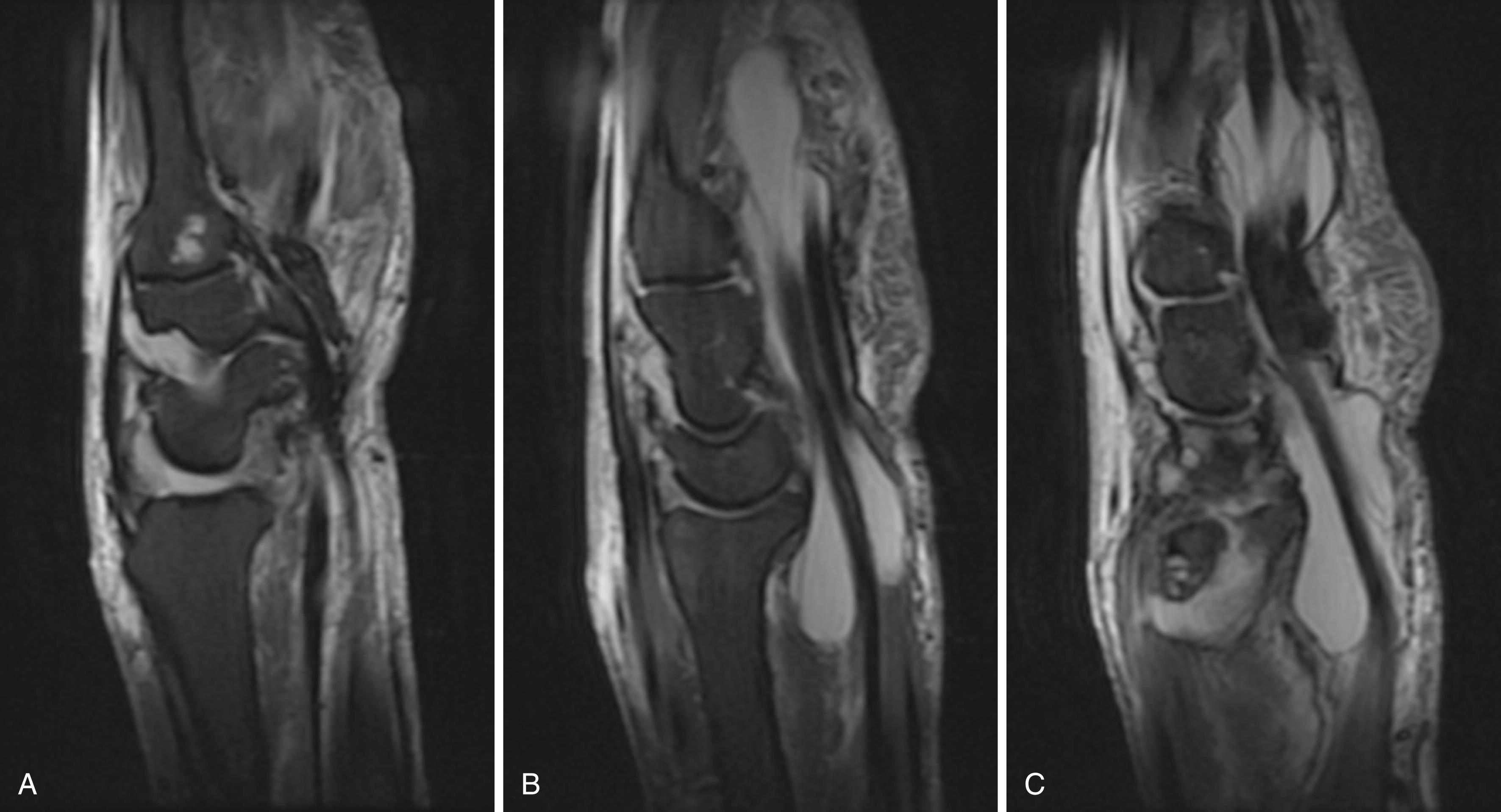
Patients with severe infections such as necrotizing fasciitis or gas gangrene or who are immunocompromised, including diabetics, should be immediately treated with broad-spectrum antibiotic therapy and emergent surgical intervention. A team approach to these critically ill patients may improve outcomes.
Surgical drainage of infections should be done through large extensile incisions. Longitudinal incisions across a flexion crease should be avoided. Excision of all necrotic tissue is imperative for infection control. In the 1800s, Louis Pasteur noted that it is the environment and not the bacterium that allows the propagation of infection. Cultures and pathology should be sent for analysis. Fungal and mycobacterial organisms are slow growing and may be more rapidly identified by staining techniques. Most wounds can be left open, with moist gauze covering the exposed surfaces. Alternatively, large wounds can be managed with a negative-pressure sponge dressing. In an acute infection, these should be changed in 48 hours. Small wounds with a tendency to heal quickly should be kept open with a gauze wick. Multiple debridements may be necessary to control infection. Amputation may be necessary to eradicate infection. In cases of severe infection, such as necrotizing fasciitis or gas gangrene, amputation may be a life-saving procedure.
Postoperatively, loose soft dressings are applied. A short period of immobilization for 24 to 48 hours may afford some pain relief to the patient. Early mobilization under the guidance of a hand therapist reduces edema, stiffness, and contracture associated with severe hand infections. For most infections isolated to the hand, we begin wound care 12 to 24 hours after surgery. Dressings are removed, and soaking in a dilute betadine solution (10:1 warm tap water:betadine) for 15 to 20 minutes twice per day is started. Active range of motion is initiated, and the wounds are redressed. Patients with betadine allergies can soak in either warm saline or a soapy solution of chlorhexidine or Castile soap (cleaner made from vegetable oils that originated in the Castile region of Spain). Although there has been a study suggesting no added value of soaks in dilute betadine, we believe this practice promotes patient participation in postoperative motion. The warm fluid facilitates tissue mobility, and the povidone iodine decontaminates the tap water and provides topical bactericidal benefits to the wound and surrounding intact tissues.
Empirical antibiotic therapy may be started after cultures have been obtained. In the case of cellulitis, where local cultures cannot be obtained, blood cultures may identify an organism and should be obtained prior to initiating antibiotic therapy. In some instances, it may be useful to aspirate an area of cellulitis. A small volume of saline is injected and reaspirated to obtain a local culture. The specific empirical therapy should be based on the most commonly encountered organisms for the type of infection being treated. The patient history, such as being exposed to an aquatic or a farm environment or being bitten by an animal, may help tailor the specific treatment to the patient. The relative prevalence of MRSA is increasing in many communities, and empirical treatment for MRSA is now commonplace. An infectious disease specialist is invaluable in guiding antibiotic recommendations for both specific infections and for resistant organisms that may be prevalent in one’s community. Table 2.1 lists general antibiotic recommendations for common infections. Dosages should be adjusted for the patient’s age, weight, renal function, and allergic status. The duration of therapy depends on the clinical response to treatment, the location and depth of the infection, and the patient’s immune status. The use of peripherally inserted central venous catheter lines can be a valuable method of providing outpatient parenteral therapy, but there is a risk of upper extremity venous thrombosis.
Tourniquet control
Elevation (not elastic) to exsanguinate the limb
Surgical incisions long and extensile
Planned to minimize exposure of blood vessels, nerves, or tendons
Avoid longitudinal incisions across flexion creases
Excision of all necrotic tissue
Obtain culture specimens from the periphery of an abscess cavity
Gram-stained smear, aerobic and anaerobic cultures
Tissue and/or fluid to pathology department and request fungal and mycobacteria stains
Copious irrigation to reduce bacterial load
Wounds should be left open after initial debridement
Negative-pressure dressings very helpful in managing large wounds
Do not be overly eager for immediate wound closure
Delayed primary wound closure or healing by secondary intention depending on infection control, wound size, and patient reliability
Frequent dressing changes for open wounds
Dressing changes every other day for negative-pressure wound care
Early motion to reduce the incidence of tendon adhesions and stiff joints
Multiple debridements may be needed to control infection
Delayed primary wound closure optional after infection is controlled
Amputation may be necessary to eradicate infection
Empirical antibiotic therapy based on most common organisms and patient history
Infectious disease consultation for antibiotic recommendations and management very helpful
| Infection Type | Most Common Organism | Other Considerations | Initial Antibiotic Therapy |
|---|---|---|---|
| Cellulitis | Staphylococcus, Streptococcus | Antibiotic synergy for streptococcal infections with clindamycin | First-generation cephalosporin or penicillin (for Streptococcus only) |
| Abscess (e.g., paronychia, felon, deep space infections) | Staphylococcus aureus | Methicillin-resistant S. aureus (MRSA) is common now in the community; start therapy for MRSA empirically and change to nafcillin or first-generation cephalosporin if infection is methicillin sensitive | IV: Vancomycin or clindamycin for inpatients Linezolid or tigecycline if unable to tolerate vancomycin Oral: Trimethoprim/sulfamethoxazole (Bactrim), clindamycin, or doxycycline |
| Flexor tenosynovitis | Staphylococcus, S. aureus, anaerobes | Polymicrobial infections have worse prognosis. Consider multimodal therapy as initial treatment until culture results are available, especially in immunocompromised patients | IV: Ampicillin/sulbactam (Unasyn) plus cefoxitin (second-generation cephalosporin) Oral: Amoxicillin/clavulanate (Augmentin) If penicillin allergic: Fluoroquinolone (ciprofloxacin or other) plus clindamycin |
| Pyarthrosis | Staphylococcus | Requires parenteral therapy MRSA is common now in the community; start therapy for MRSA empirically and change to nafcillin or first-generation cephalosporin if infection is methicillin sensitive Consider coverage for Neisseria gonorrhea in sexually active patients |
IV: Vancomycin Add ceftriaxone for N. gonorrhea coverage Presumptive treatment for MRSA until cultures are available; then change to antibiotic appropriate to organism with the least side effect profile |
| Human bite | Staphylococcus, Streptococcus, Eikenella corrodens, anaerobes | IV: Ampicillin/sulbactam (Unasyn) plus cefoxitin Oral: Amoxicillin/clavulanate (Augmentin) If penicillin allergic: Fluoroquinolone (ciprofloxacin) plus clindamycin Alternative: Third-generation cephalosporin plus anaerobic coverage with clindamycin or metronidazole Note: Quinolones not indicated in children |
|
| Animal bites | Pasteurella multocida, Staphylococcus, Streptococcus | IV: Ampicillin/sulbactam (Unasyn) plus cefoxitin Oral: Amoxicillin/clavulanate (Augmentin) If penicillin allergic: Fluoroquinolone plus clindamycin Alternative: Third-generation cephalosporin plus anaerobic coverage with clindamycin or metronidazole Note: Quinolones not indicated in children |
|
| Suspected CA-MRSA (community-acquired MRSA) | Suspected based on clinical appearance and relative frequency of CA-MRSA seen in community | IV: Vancomycin or clindamycin Oral: Trimethoprim/sulfamethoxazole (Bactrim), clindamycin |
|
| Suspected HA-MRSA (hospital-acquired MRSA) | IV: Vancomycin, linezolid, or daptomycin | ||
| Necrotizing fasciitis | Streptococcus or polymicrobial infection | Treat both until organisms identified | Broad-spectrum beta-lactam (piperacillin/tazobactam; imipenem) plus vancomycin (for MRSA) plus clindamycin (for synergy for Streptococcus pyogenes ) |
| Gas in soft tissues | Clostridium. perfringens (gas gangrene), polymicrobial infections (anaerobic and facultative anaerobes) | Intravenous drug abusers and diabetics more often have polymicrobial infections; often, gas in the soft tissues | High-dose penicillin plus clindamycin Broad-spectrum beta-lactam (piperacillin/tazobactam; imipenem) plus vancomycin (for MRSA) plus clindamycin (for synergy for S. pyogenes ) |
Paronychia is the most common infection in the hand, affecting women three times more commonly than it affects men. , It is generally treated by primary care physicians, although refractory cases are often seen by the hand surgeon. Acute paronychia involves the soft tissue fold around the fingernail. It usually results from the bacterial inoculation of the paronychia tissue by a sliver of nail or hangnail, by a manicure instrument, or through nail biting. The disruption of the barrier between the nail fold and the nail plate allows the introduction of bacteria into the tissue bordering the nail ( Fig. 2.3 ). Although most paronychias are mixed infections, the most common infecting organism is S. aureus.
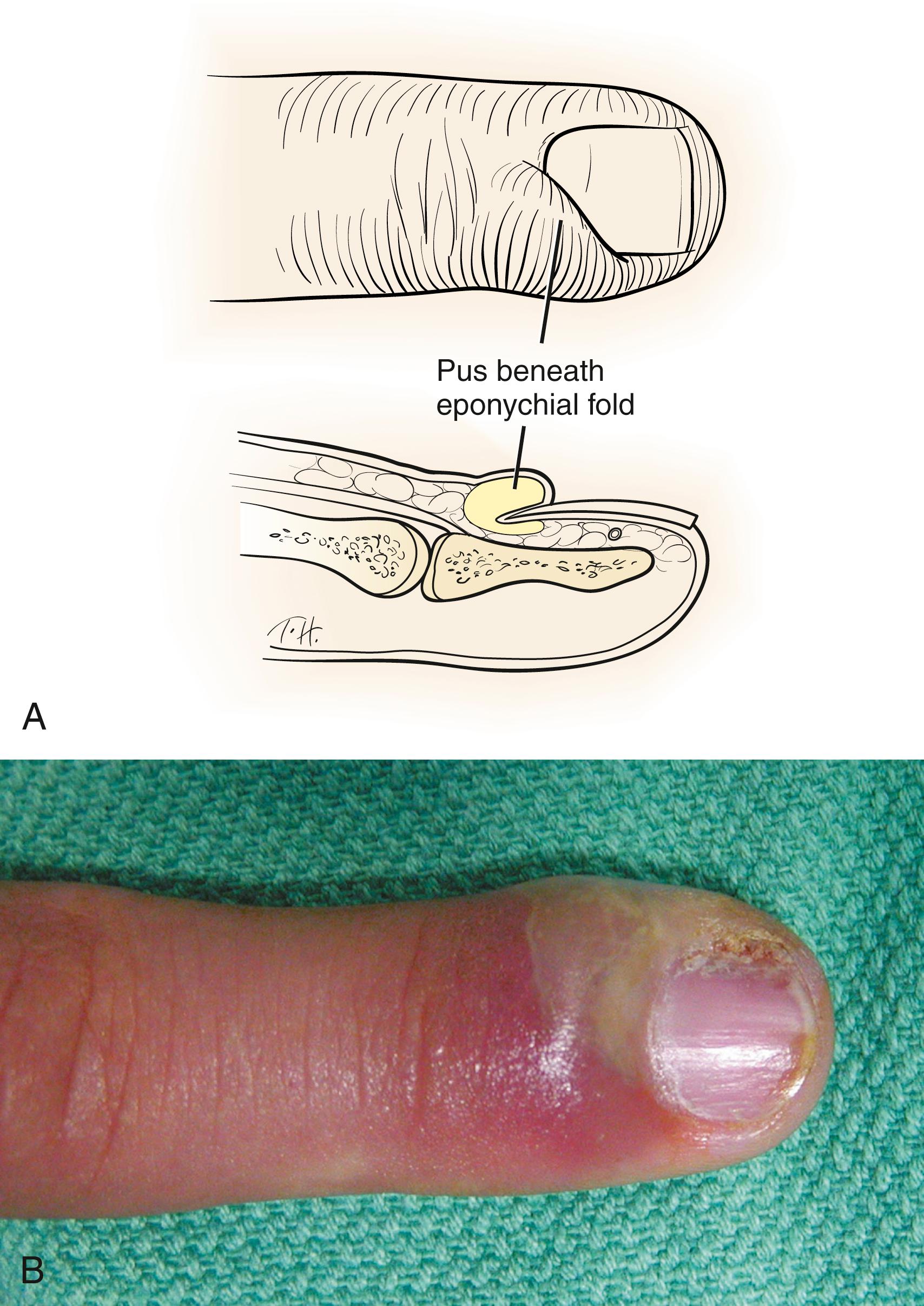
Erythema, swelling, and tenderness immediately adjacent to the nail are the hallmarks of the early clinical presentation. If left untreated, an abscess may form along the nail fold. The abscess may extend below the nail plate, either partially or completely, or it can track in a volar direction into the pulp space. Because of the continuity of the nail fold with the eponychial tissue overlying the base of the nail, the infection can extend into this region and may continue around to the fold on the opposite side of the fingernail. This unusual occurrence is called a “runaround infection.” Infection involving the entire eponychium, as well as one lateral fold, is known as an eponychia. An eponychia is usually manifested as a collection of pus beneath the proximal portion of the nail in the region of the lunula. It is rare to see both lateral folds and the dorsal tissue infected in the same digit.
Radiographs and laboratory examination are not necessary in uncomplicated cases with early clinical findings. However, patients who have not responded to initial treatment, have recurrent infection, or who present with considerable swelling or abscess should be evaluated for underlying systemic diseases such as diabetes. The patient’s history and examination will direct the need for wound cultures for atypical organisms, radiographs to evaluate for a foreign body or osteomyelitis, and laboratory evaluation. Empirical therapy usually is a first-generation cephalosporin. For patients who are noted to be nail biters, a penicillin with a beta lactamase inhibitor may be a better antibacterial agent to cover E. corrodens. Patients who do not respond to empirical therapy with a first-generation cephalosporin may also have CA-MRSA infection and may respond to a change in antibiotic therapy.
The nail complex consists of the nail bed, nail plate, and perionychium. The nail bed, which lies below the plate, consists of the germinal and sterile matrices. The germinal matrix is responsible for the majority of nail growth. The proximal portion of the nail sits below the nail fold. The border tissue surrounding the nail is the perionychium. The eponychium is the thin layer of tissue extending from the nail wall onto the nail plate. The hyponychium is the mass of keratin just distal to the sterile matrix, below the distal nail plate. This area of the nail complex is highly resistant to infection.
In the very early stages, this infection can be treated by soaks in a warm solution, systemic oral antibiotics, and rest of the affected part. If there is a superficial abscess, treatment can be carried out with local anesthesia and should consist of elevation of the cuticle away from the nail plate in the area of erythema and opening the thin layer of tissue over the abscess with a sharp blade directed away from the nail bed and matrix. Drainage of the abscess is performed where the abscess most nearly approaches the surface ( Fig. 2.4 ). The patient is counseled regarding high-risk activities, such as nail biting and manicures.
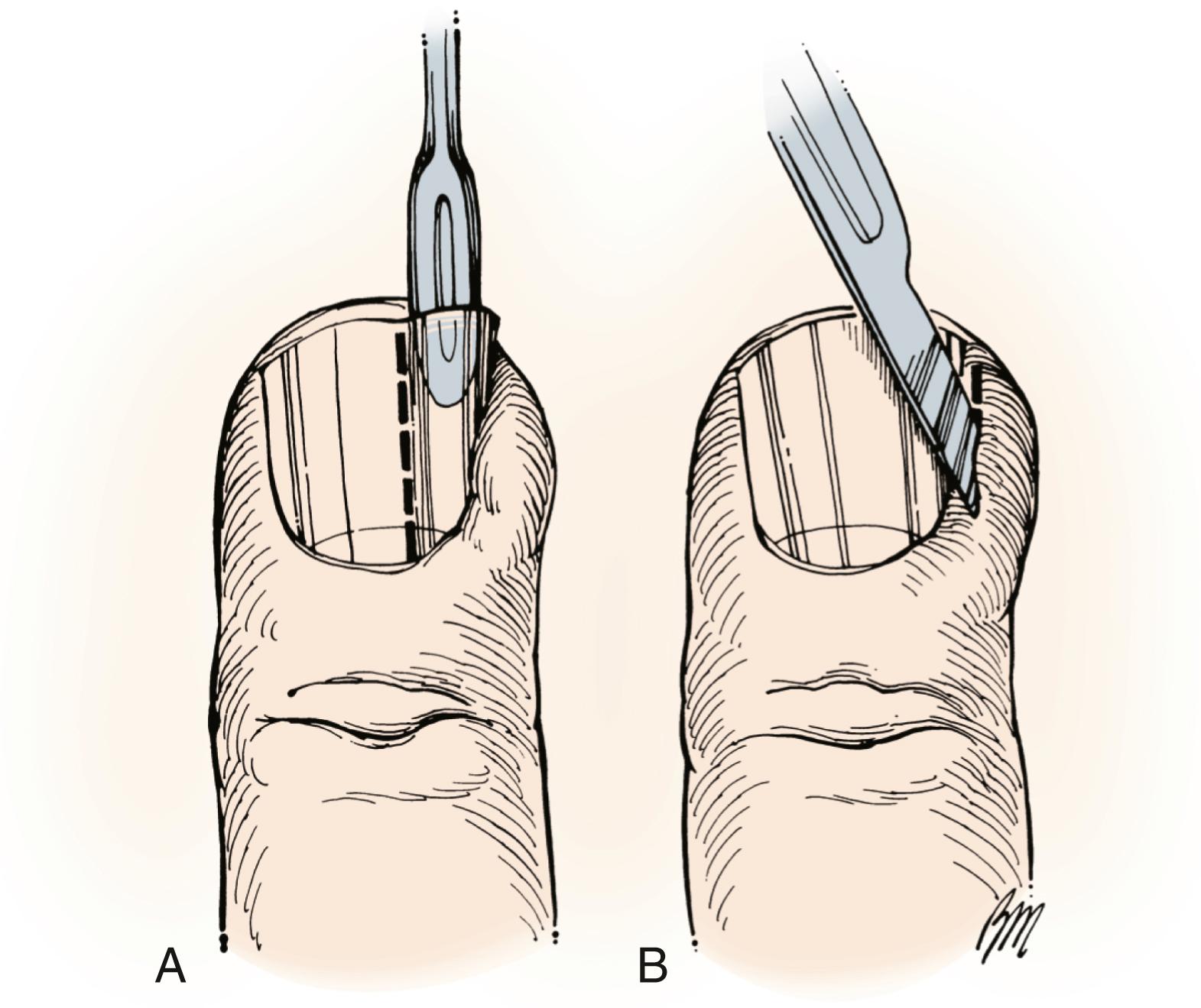
More extensive infection requires individualized treatment based on the extent of the lesion. Surgical decompression is best carried out under digital block anesthesia at the level of the metacarpal head with plain lidocaine. If the perionychial fold and the adjacent part of the eponychium are involved, the perionychium and skin adjacent to the nail fold are released. If the perionychial infection tracks in a volar direction and involves the pulp, the incision should be deep enough to fully drain the abscess and allow evaluation of bone involvement of the distal phalanx. Infection that travels below the nail plate requires removal of a portion of the nail. If the entire nail matrix is involved, then the entire nail is removed. Purulence below the nail plate can cause pressure on the germinal matrix, resulting in ischemia of the germinal matrix and temporary or permanent arrest of nail growth.
The paronychial sulcus is elevated from the nail gently by a flat, blunt instrument, such as the flat portion of a small malleable or metal probe or a Freer elevator. Sharp incision may be used as well. The incision is directed away from the nail bed to avoid injury to the nail bed and subsequent growth abnormality. The incision may be extended proximally along the nail fold, as far proximally as is necessary ( Fig. 2.5A and B). It is generally sufficient to carry the incision only to the proximal edge of the nail, but it may extend as far proximally as the distal interphalangeal (DIP) joint.
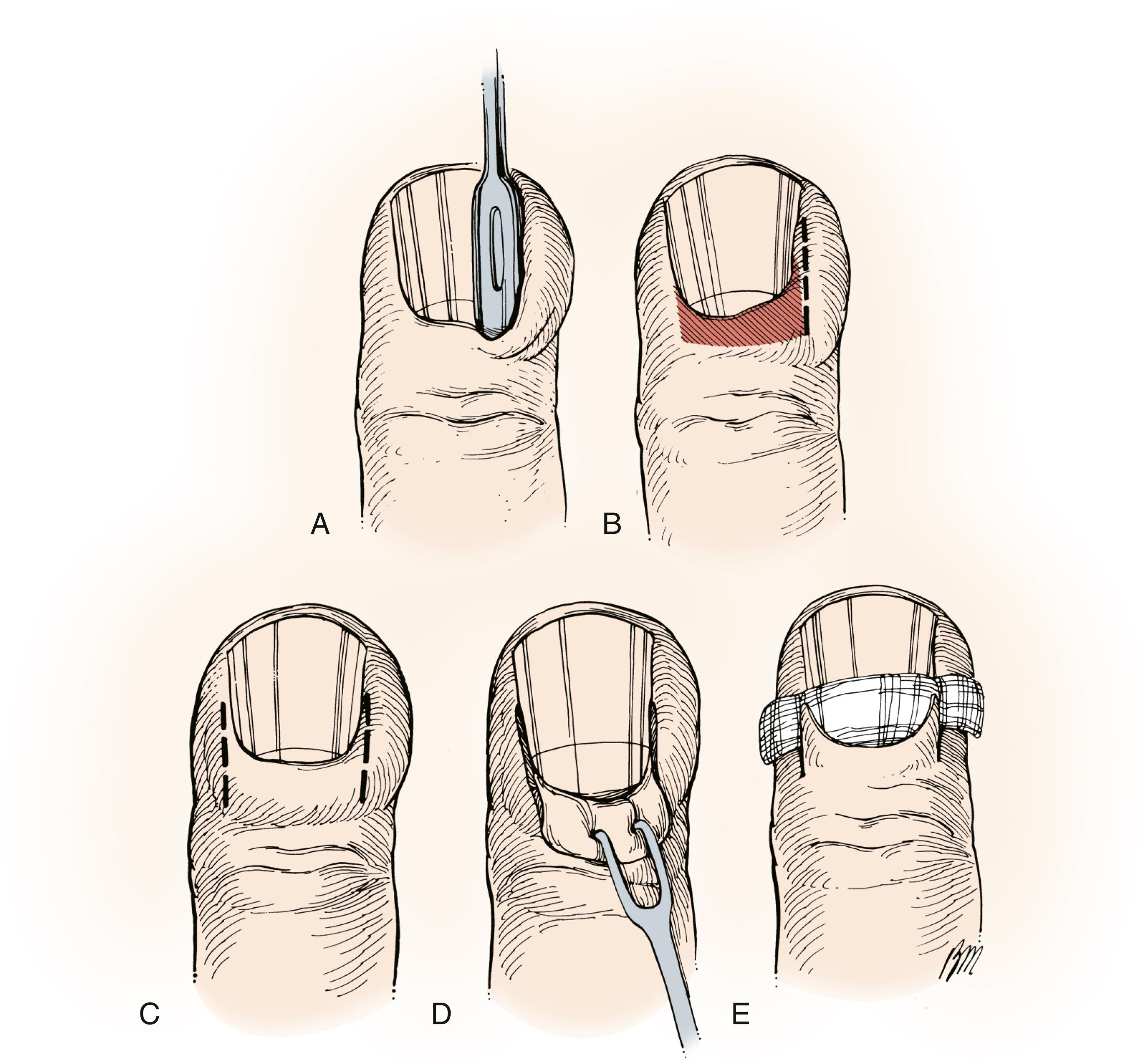
When abscess or fluctuance is found below the eponychium and a single incision does not adequately expose or decompress the involved tissues, a parallel incision along the opposite nail fold is made, allowing the eponychium and nail fold to be elevated and reflected above the nail plate (see Fig. 2.5C to E).
When the abscess extends below the nail plate, a portion of the nail plate should be removed. The amount and location of nail removal depend on the location and extent of involvement below the nail. If the area of fluctuance lies adjacent to the perionychium, a flat blunt probe or Freer elevator is used to separate the affected portion of the nail plate from the nail bed. The nail plate is then cut with a small scissors and removed. In the rare case where the eponychium is infected and pus is present only below the proximal portion of the nail, the eponychium and nail plate are elevated through a single or double incision. The proximal third of the nail plate is carefully removed. Only when the nail is entirely separated from the underlying matrix is it necessary to remove the entire nail plate. After decompression, the area of abscess is irrigated. The wound is left open with a small thin piece of gauze that allows the wound to stay open and drain.
No single treatment regimen is used in every case. Early infections are treated nonsurgically, with oral antibiotics and soaks two to three times per day in a solution of warm water soaked in dilute betadine. Antibiotic treatment should cover S. aureus.
Surgical treatment depends on the location and extent of the perionychial infection. In general, we release along the perionychial sulcus, extending proximally to the level of the nail base. Double incisions are reserved for more extensive eponychial involvement or when removal of the proximal portion of the nail is planned. Removal of any portion of the nail is done only when the area of abscess extends below the nail plate. Removal of the entire nail is necessary only when the entire nail plate is separated from the nail matrix by abscess.
Perionychial or eponychial infection with abscess
None required in healthy individual with acute infection
Laboratory evaluation in diabetics or immunocompromised patients
Radiographs if long-standing infection or no improvement with conventional therapy
Careful evaluation for infection residing below the nail plate or in finger pulp
Incise with blade facing away from nail bed to reduce risk of injury to matrix
Misdiagnosis as herpetic whitlow (see section on herpetic whitlow)
Failure to recognize underlying osteomyelitis
Underlying systemic illness or atypical organism leading to refractory infection
Oral antibiotics for 7 to 10 days
Daily soaks in dilute povidone-iodine solution or other solution (saline, warm soapy water, Epsom salts)
Early finger range of motion
Postoperatively, the patient is given oral antibiotics for 7 to 10 days, depending on the severity of the infection. Dressings are changed two to three times per day, coinciding with soaking of the affected finger for 5 to 10 minutes. We discontinue packing or wicking the wound at 3 to 4 days, or when the infection has resolved and the wound is healing. Occlusive dressings can lead to skin maceration and should be avoided. Early motion is emphasized to prevent stiffness.
Improvement is noted in most acute cases of paronychia in 3 to 4 days with appropriate management; however, some tenderness and hypersensitivity around the surgical scars can be expected for several months. Nail deformity can occur either as a result of the infection or after iatrogenic injury to the nail matrix. Patients with an underlying medical illness may require a longer time for healing, recover more slowly, require additional surgery, and have a higher risk of recurrent infection.
Complications are rare but do occur. Nail deformity can occur either from the infection itself or from iatrogenic injury to the nail matrix during decompression. The risk of injury is minimized by gently separating the nail plate from the underlying matrix and by directing the scalpel blade away from the matrix when incising around the nail bed. Persistent infection despite appropriate treatment may be due to insufficient surgical decompression and drainage or inadequate antibiotic coverage. If the infection is not resolving at 1 week, radiographs to evaluate for osteomyelitis, cultures with antibiotic sensitivities, and repeat surgical debridement are necessary. Robbins, in his series from the 1950s, found that the most frequent complication of a paronychia was extension to the pulp space through a sinus at the side of the nail. This complication occurred in 13.5% of his patients. Today, the spread to the pulp space is rare owing to improved antibiotic therapy and more aggressive surgical treatment. In children with long-standing paronychia, infection can lead to bone involvement (osteomyelitis) and epiphyseal separation.
Misdiagnosis of a paronychia can occur, particularly confusion with herpetic whitlow. Distinguishing herpetic whitlow from a bacterial infection is important. Incision and drainage of herpetic whitlow are contraindicated and can result in systemic viral infection and/or bacterial suprainfection.
Chronic paronychia is characterized by indurated and rounded eponychium and is a distinct problem from acute paronychia. Chronic paronychia was once felt to be a result of repeated bacterial and fungal infections; however, the current view suggests that chronic paronychia represents a eczematous condition with multifactorial etiology. , This problem is more common in middle-aged women, with a female-to-male ratio of 4:1. Frequent water immersion, particularly in detergents and alkali solutions, is a predisposing factor. Housewives, bartenders, dishwashers, nurses, swimmers, and children who suck their fingers are often affected. Chronic paronychia also more commonly affects patients with diabetes and psoriasis. Cultured organisms include gram-positive cocci, gram-negative rods, Candida, and mycobacterial species. Preoperative evaluation includes a thorough history for contributing environmental factors and laboratory evaluation for underlying systemic diseases such as diabetes or immunosuppression. Radiographic evaluation is also indicated assessing for a foreign body, osteomyelitis, or a bony lytic or blastic process that could indicate a tumor (primary or metastatic). If the lesion is suspicious for a tumor, an MRI study may be tumor required.
Chronic paronychia begins with separation between the nail plate and the dorsal soft tissue covering the nail plate, including the cuticle, eponychium, and nail fold. This leads to colonization, usually by staphylococcal organisms. Subsequent infection, by Candida albicans and/or colonic organisms, leads to chronic inflammation and recurrent exacerbations with episodic erythema and drainage. This chronic inflammation leads to fibrosis and thickening of the eponychium, with a resultant decrease in vascularity to the dorsal nail fold. The decreased vascularity reduces the resistance to minor bacterial insults, allowing for recurrent episodes of symptomatic exacerbations. ,
Conservative therapies for chronic paronychial infection have included topical corticosteroids, topical tacrolimus, oral and topical antibiotics, and oral and topical antifungal agents. Although reducing exposure to moist environments and chemical irritants may be helpful, these treatments alone have been uniformly unsuccessful. , Studies from the dermatologic literature found that topical corticosteroids and even topical tacrolimus are more effective than topical antifungals, implicating the relative importance inflammatory element over the mycological component. ,
Eponychial marsupialization is the most common surgical treatment for the chronic paronychium. Under digital block anesthesia and tourniquet control, a crescent-shaped incision is made beginning 1 mm proximal to the distal edge of the eponychial nail fold and extending proximally for 3 to 5 mm. Some authors recommend removal of all thickened tissue. Others have found a 3-mm margin adequate to achieve equal results. The crescent should be symmetrically shaped and extend to the edge of the nail fold on each side ( Fig. 2.6 ). The crescent of tissue is removed down to but not including the germinal matrix. The wound is left open and allowed to drain. If nail deformity is present, removal of the nail has been reported to improve the cure rate and reduce the risk of recurrence. Pabari and colleagues have described elevation of the nail fold, inverting and folding this tissue over a nonadherent gauze, and anchoring the inverted skin proximally with a nonabsorbable suture. Anchoring sutures are removed between 2 and 7 days, and the nail fold is allowed to return to its original position ( Fig. 2.7 ).
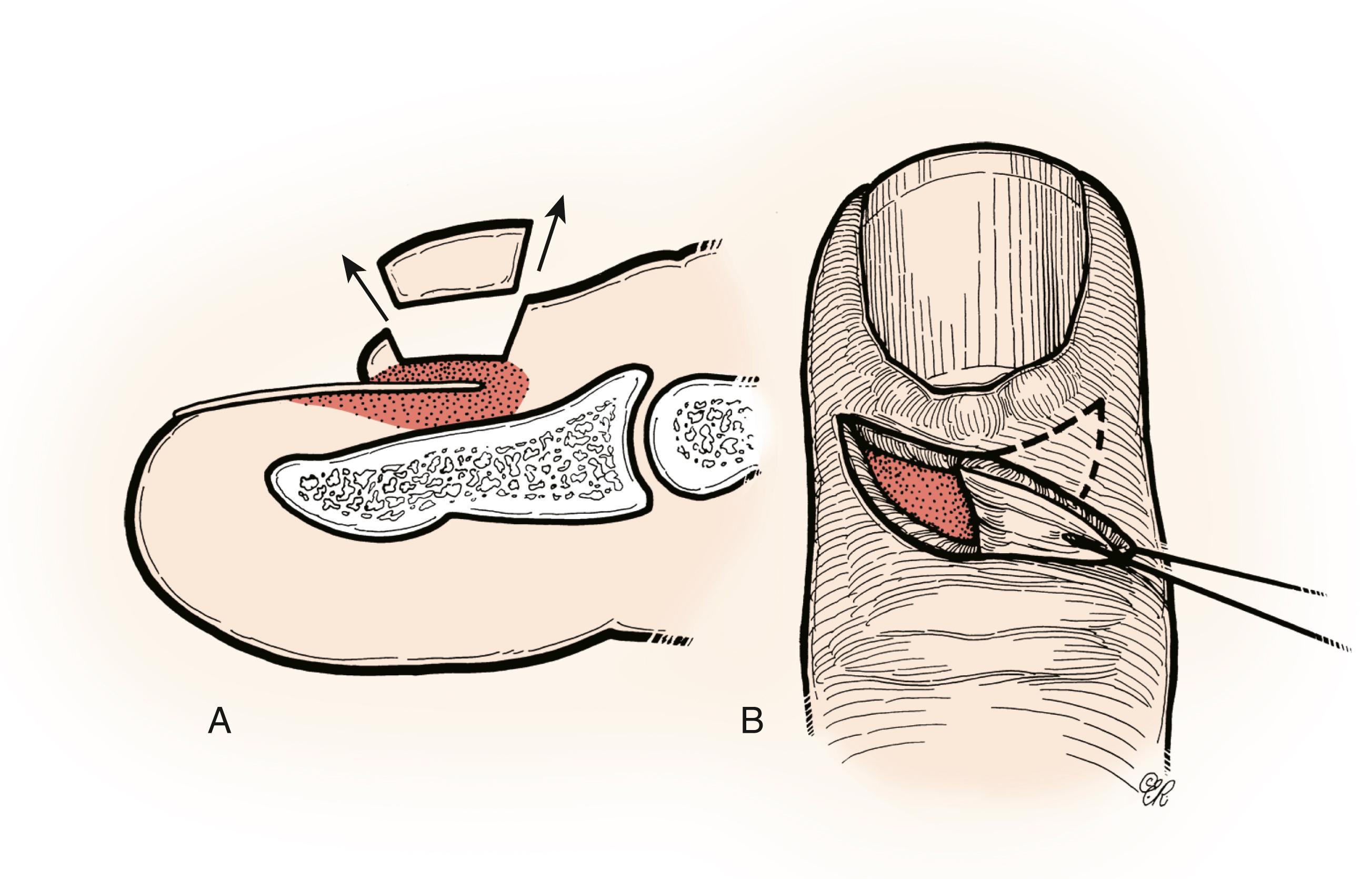
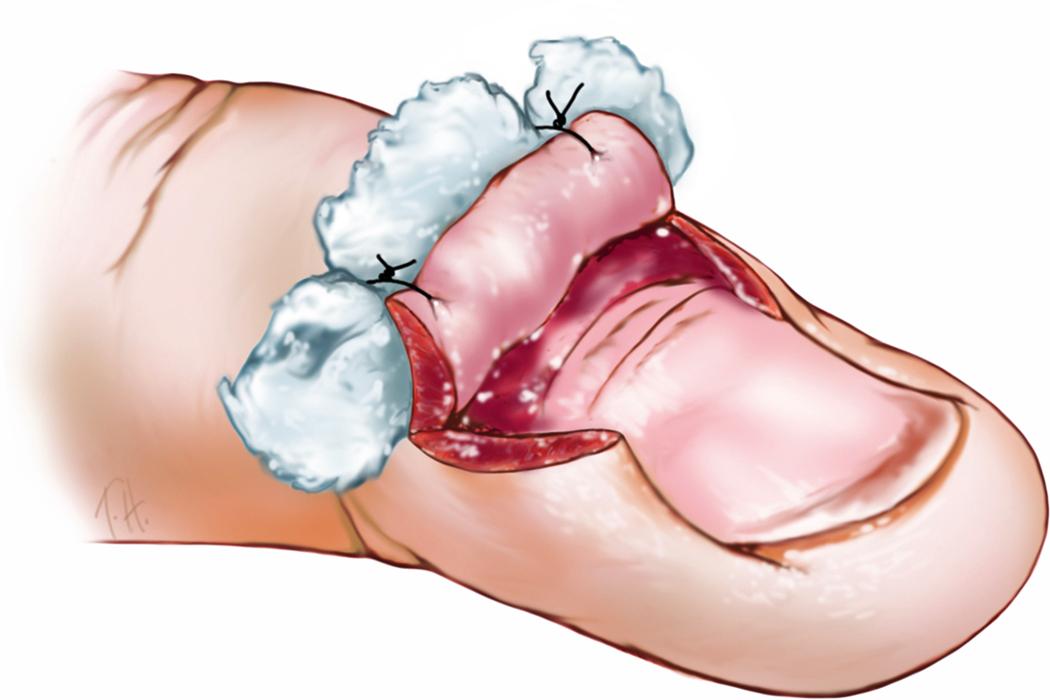
We have found eponychial marsupialization an effective treatment for chronic paronychia recalcitrant to nonoperative management. We agree with Bednar and Lane that a 3-mm crescent of tissue is adequate, and removal of all thickened tissue is not critical to the outcome. Special care is used to avoid injury to the germinal matrix. The removed tissue is sent for bacterial, fungal, and mycobacterial culture. The remaining tissue is sent for pathologic examination. Nail removal is performed when a nail deformity is present. Wounds are covered with Xeroform® (absorbent, fine-mesh gauze impregnated with a petrolatum blend; 3% bismuth tribromophenate) gauze. When the nail is removed, Xeroform gauze is placed in the nail bed and nail fold as well.
Patients are instructed to avoid moist environments. Predisposing systemic conditions, such as diabetes and psoriasis, are medically controlled. We inquire about activities that may lead to mycobacterial exposures, such as home aquariums or terrariums, marine work, or aviary exposure.
The postoperative dressing is removed at 48 to 72 hours by soaking in 3% hydrogen peroxide solution. The patient is instructed to soak the area three times per day in dilute povidone-iodine solution. This continues until 2 days after all drainage has stopped. Oral antibiotics are given for 2 weeks. If cultures are negative or the organism is not sensitive, the antibiotic therapy is discontinued at 3 to 5 days.
Most chronic paronychial infections resolve with marsupialization. Systemic or topical antibiotics or antifungal agents are often not required. Wound healing by secondary intention occurs over 3 to 4 weeks. Scar sensitivity is more common than in acute paronychia and may persist for several months. Nail deformity is also more common than in treatment of acute paronychia. Six to 12 months of nail growth is necessary before an accurate assessment of residual deformity can be performed. Recurrence rates are higher if the patient does not correct environmental factors or if systemic diseases are not medically controlled. In the event of recurrence, remarsupialization and nail removal should be done.
Chronic eponychial infection
Thorough workup and social history for contributing factors
Laboratory evaluation in diabetics or immunocompromised patients
Radiographs
Nail removal in conjunction with marsupialization if nail deformity is present
Nail removal and remarsupialization in recurrent cases even with normal nail
Protect the germinal matrix during marsupialization.
Misdiagnosis with tumor or cyst
Unrecognized systemic illness
Failure to correct environmental factors
Oral antibiotics for 10 to 14 days if cultures are positive. Different antibiotics if mycobacterial organism present
Consider oral antifungal medications
Daily soaks in dilute povidone-iodine solution
Early finger range of motion
The term felon probably has its roots from the Latin fel, meaning “bile” or “venom.” A felon is a subcutaneous abscess of the distal pulp of a finger or thumb ( Fig. 2.8 ). However, not all abscesses of the distal phalanx are felons. Superficial infections of the most distal part of the pulp skin are known as “apical infections.” Apical infections are distinct from the felon in that the palmar pad is not involved. The term felon should be reserved for those infections involving multiple septal compartments and causing compartment syndrome of the distal phalangeal pulp. The most commonly cultured organism from felons is S. aureus. Infections from gram-negative organisms have also been reported. These are uncommon and more typically seen in immunocompromised patients or diabetics.
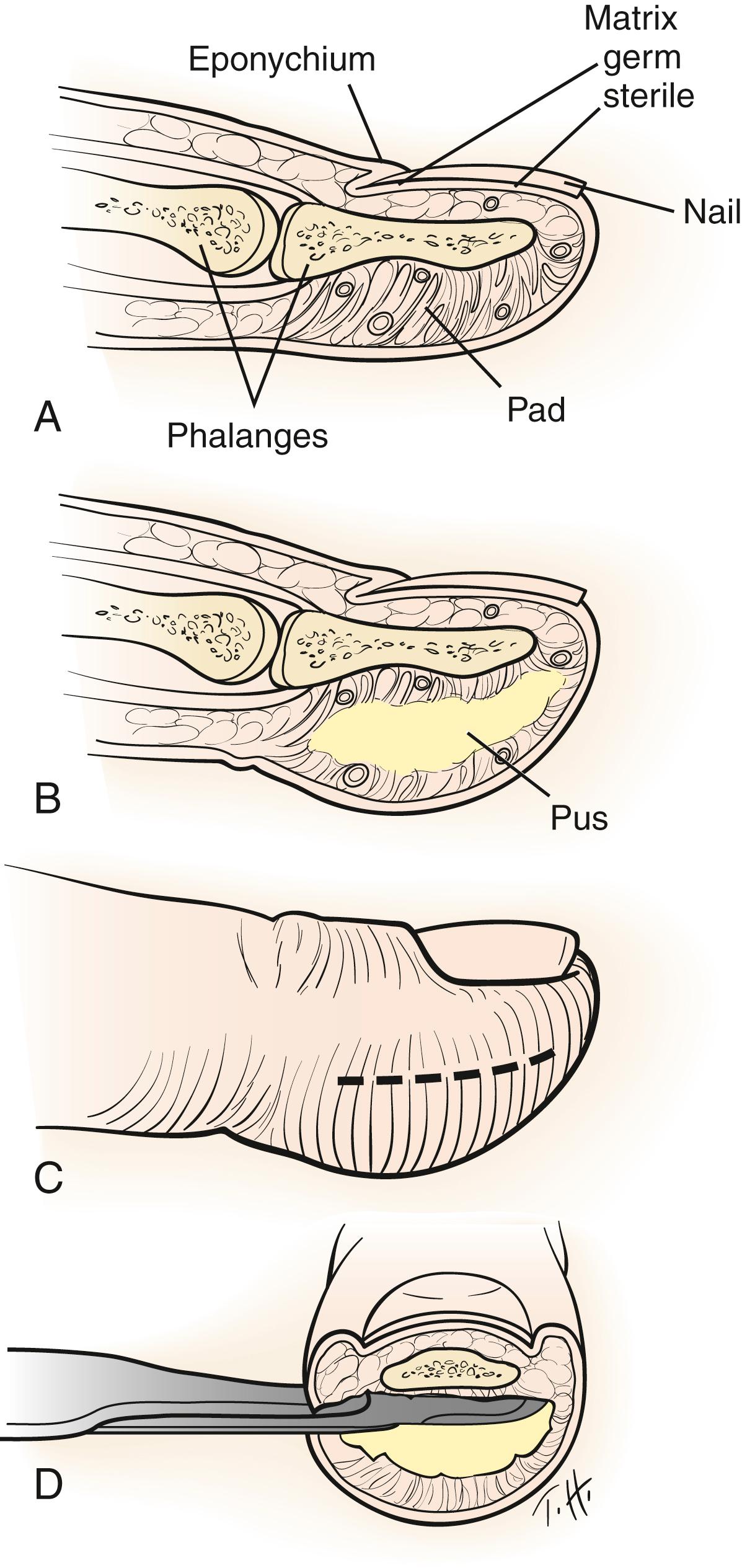
Felons account for 15% to 20% of all hand infections. A felon is characterized by severe throbbing pain, tension, and swelling of the entire distal phalangeal pulp. The pulp space is exquisitely tender, but the associated swelling does not extend proximal to the DIP flexion crease, unless the joint or tendon sheath is involved. With the progression of swelling and tension, there is compromised venous return, leading to microvascular injury and development of necrosis and abscess formation. There is often a preceding history of penetrating injury, such as a wood splinter, glass sliver, or minor cut. “Finger-stick felons” can be seen in diabetics, who repeatedly traumatize the fingertip for blood tests. Once the felon has developed, the patient may attempt a decompression with a knife or needle. The pain and swelling usually develop rapidly. The expanding abscess breaks down the septa and can extend toward the phalanx and produce osteitis or osteomyelitis, or it can extend toward the skin and cause necrosis and a sinus somewhere on the palmar surface of the digital pulp. If adequate decompression does not occur, the digital vessels will thrombose with resultant sloughing of the tactile pulp ( Fig. 2.9 ; Case Study 2.2 ). Other complications of an untreated felon include sequestration of the diaphysis of the distal phalanx, pyogenic arthritis of the DIP joint, and flexor tenosynovitis, although the last is quite rare.
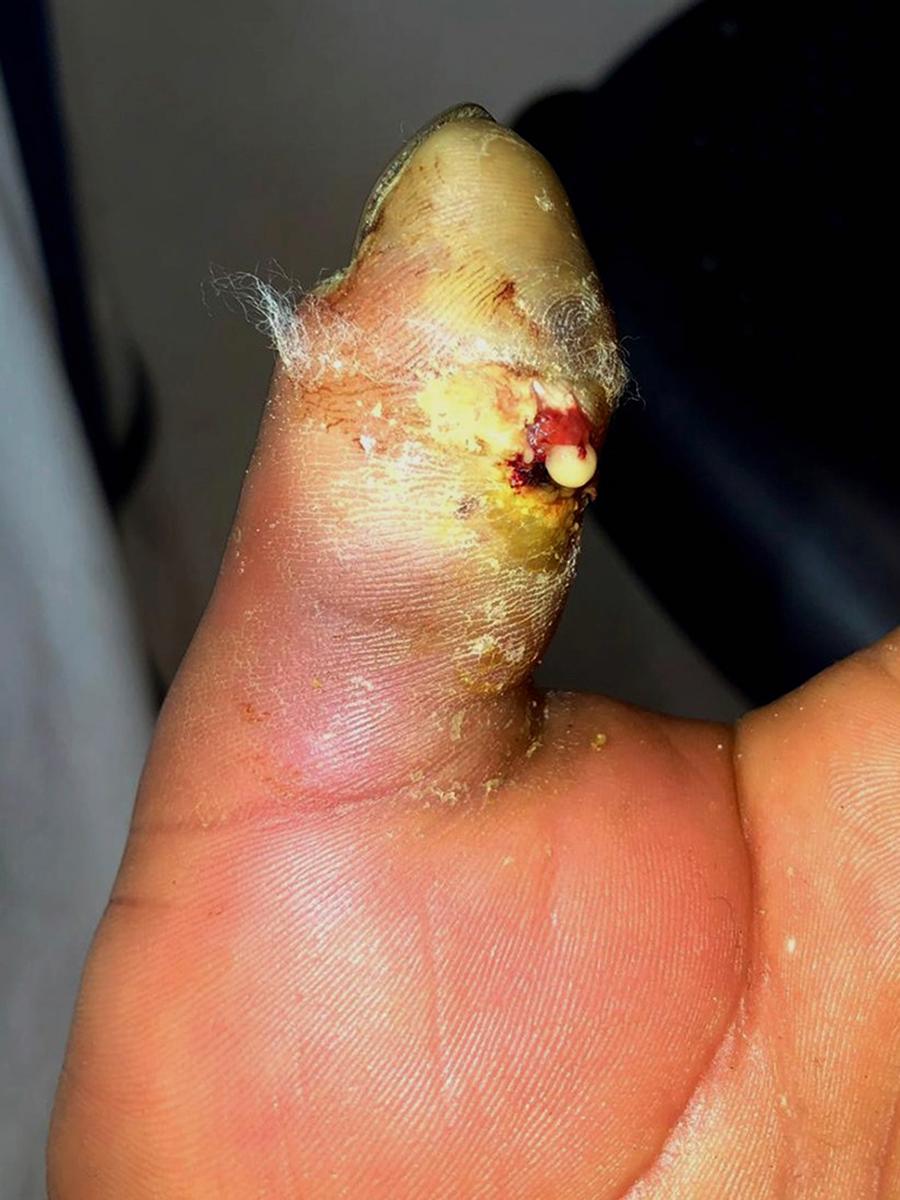
FLOAT NOT FOUND
A 40-year-old presented to the emergency room with more than 1 week of thumb pain. He clinically showed signs of a pulp space infection of the thumb (felon) with possible thenar space abscess ( eFig. 2.4 ). He was taken emergently to the operating room. Purulence was noted tracking proximally ( eFig. 2.5 ). The pulp appeared necrotic. The bone was soft and evidently infected. An amputation through the interphalangeal joint was performed at subsequent debridement ( eFig. 2.6 ).
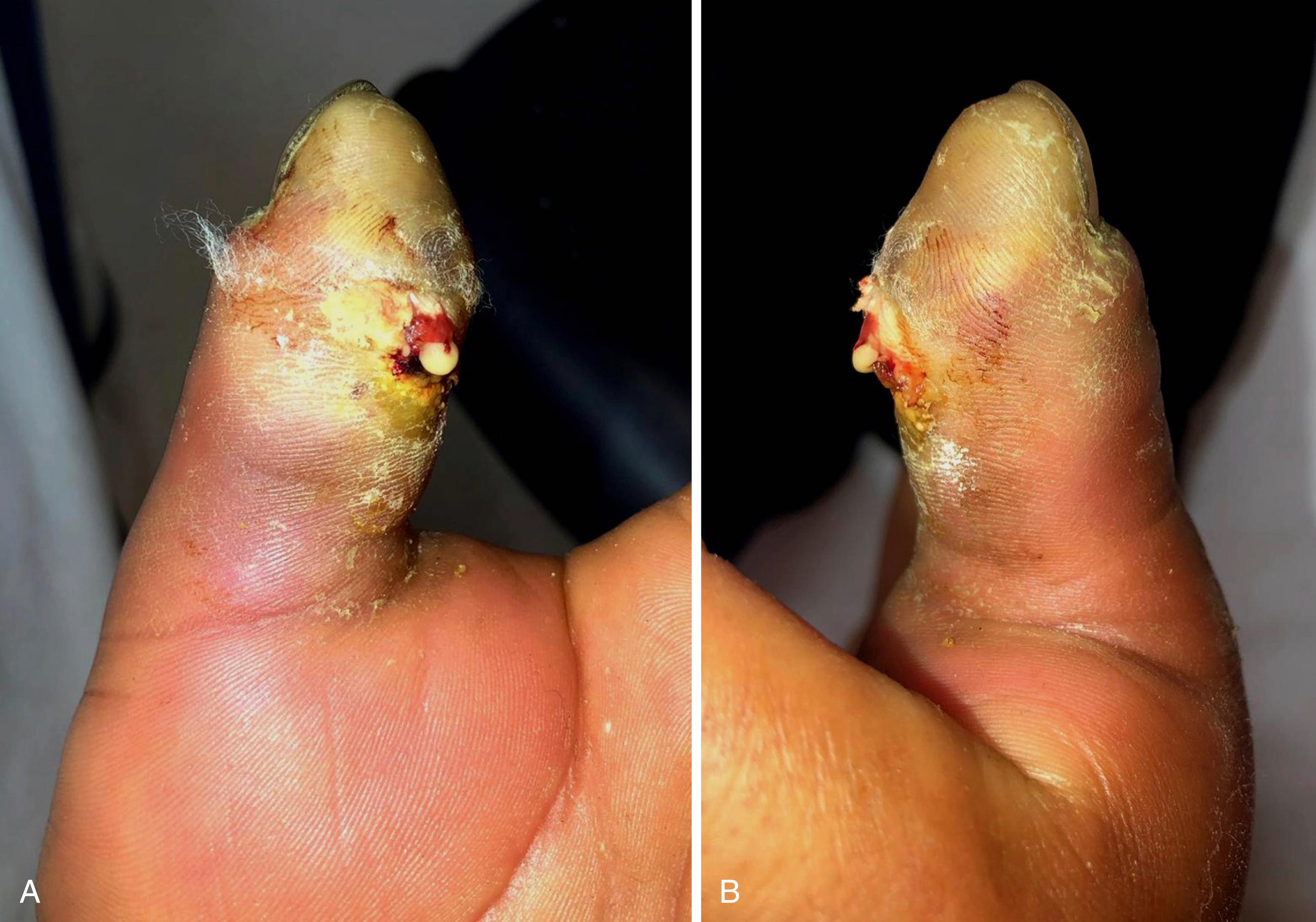
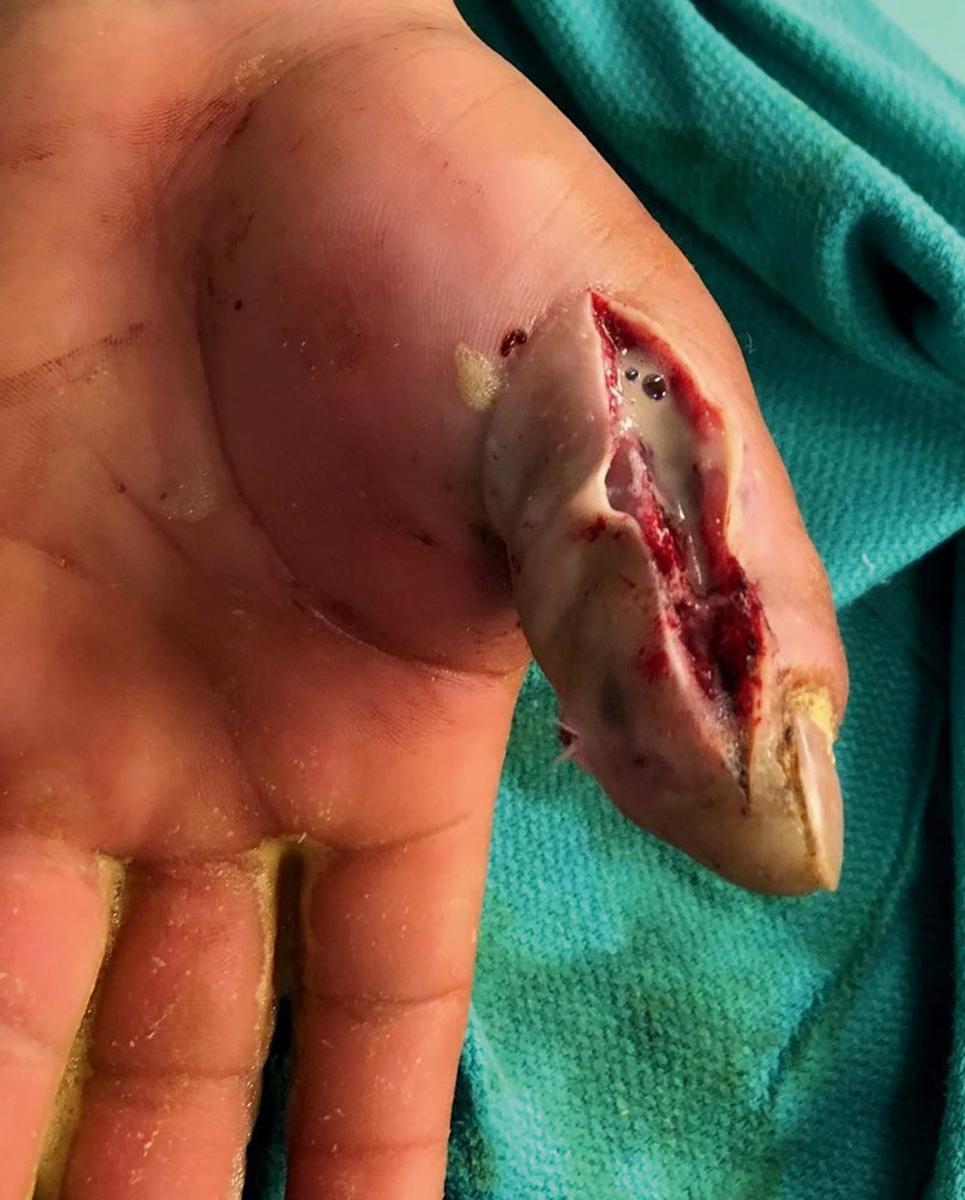
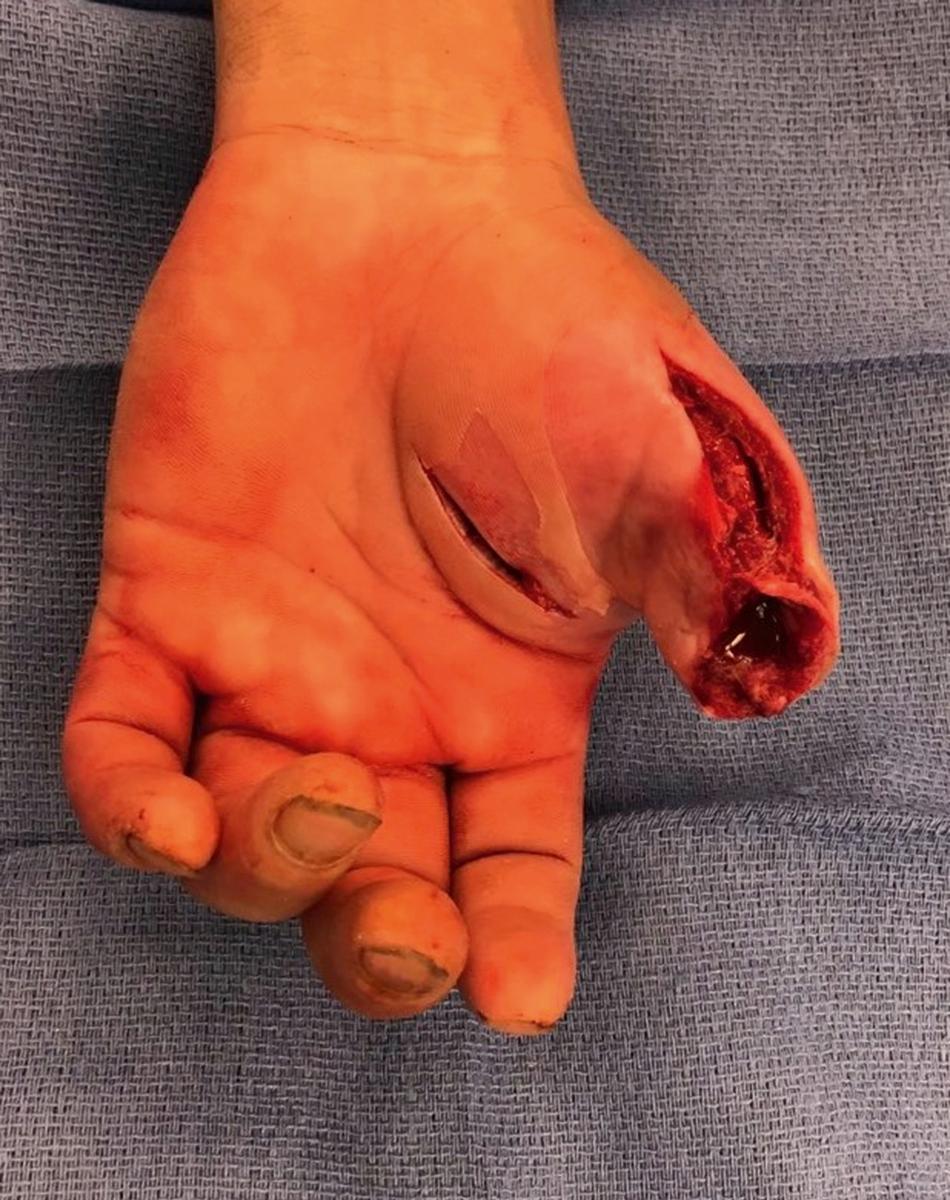
Kanavel studied the anatomy of the fingertip through multiple sagittal and coronal sections of cadaveric fingers. He described the anatomy of the distal pulp as a “closed sac connective tissue framework, isolated and different from the rest of the finger.” Multiple vertical trabeculations divide the pulp of the distal phalanx into a latticework of separate septal compartments. The trabeculae attach the periosteum of the distal phalanx to the epidermis, giving the fingertip structural support and stabilizing the pulp during pinch and grasp. The septal interstices are filled with fat globules and eccrine sweat glands, which open onto the epidermis and provide an access for surface bacteria to enter the pulp space. The digital arteries run parallel to the distal phalanx, giving off a nutrient branch to the epiphysis before entering the pulp space. The diaphysis is supplied principally from volar nutrient vessels from the terminal branches of the digital arteries. The terminal branches of the digital nerve are parallel and palmar to the digital arteries. They arborize extensively within the pulp of the distal phalanx, providing fine tactile discrimination. The highest concentration of sensory receptors in the hand is in the volar aspect of the distal phalanx.
Felons may begin with penetrating wounds of the distal pulp or as bacterial contamination of the fat pad through the eccrine sweat glands. Inflammation and cellulitis lead to local vascular congestion, which is exacerbated by the closed septal anatomy of the pulp. If left untreated, tissue necrosis and abscess formation follow, resulting in further microvascular impairment. The increased pressure within the pulp as a “closed sac” results in a clinical situation resembling a compartment syndrome. The ischemia of the pulp causes severe ischemic pain in the densely innervated pulp. The blood supply to the periosteum and diaphysis is compromised more than the blood supply to the skin, leading to bone necrosis and sequestration followed by spontaneous decompression of the felon through the skin. In children, infection or necrosis of the epiphysis is rarely seen, most likely owing to the preservation of the epiphyseal nutrient artery, which arises from the digital artery proximal to the closed space of the distal pulp.
Treatment of the felon should be directed toward preserving the function of the finger pulp. These functions include fine tactile sensibility and a stable durable pad for pinch. In the early cellulitic phase, it may be possible to treat the felon with elevation, antibiotics, and soaks. Short-term immobilization provides comfort. Some authors recommend surgical drainage only in the presence of abscess. In our hands, surgical drainage is indicated when the pulp is very tender, tense, or fluctuant. The basic tenets of all approaches are to avoid injury to the digital nerve and vessels. The incision should avoid leaving a disabling scar, provide adequate drainage, and elude inadvertent violation of the flexor tendon sheath, which could lead to an iatrogenic flexor tenosynovitis.
Several surgical incisions have been described ( Table 2.2 ; Fig. 2.10 ); some of these are of historic interest only and are no longer recommended. Surgery may be performed under digital block anesthesia or under general anesthesia. A tourniquet is helpful for visualization. Regardless of the type of incision, surgical decompression requires release of all of the septa, debridement of necrotic tissue, irrigation, and wound management to allow continued drainage of the abscess cavity. To keep the wound open and draining, a gauze wick is placed in the wound. The first dressing change is done at 24 to 48 hours. Authors’ opinions vary as to how long to keep the wound open with a wick drainage. Depending on the severity of infection, 2 to 5 days should be adequate for most cases. Soaking in dilute povidone-iodine solution, as described earlier, is initiated after the first dressing change and continued until wound healing by secondary intention.
| Incision | Advantages | Disadvantages | Comments and Technical Points |
|---|---|---|---|
| A: Fish-mouth incision ( Fig. 2.10A ) | None | Risks circulation leading to skin slough; unstable pulp; unsightly scar | No place in treatment |
| B: “J” or hockey-stick incision ( Fig. 2.10B ) | Good for extensive or severe abscess | Incision coming distally into the fingertip can cause painful scar | Adequate debridement and release of septa can be performed without crossing the fingertip (see F) |
| C: Through-and-through incision ( Fig. 2.10C ) | Wide access to all involved septal compartments | Additional wound; superfluous incision that can compromise circulation to the pulp | Initially described with a “J” incision on the ulnar side with a longitudinal counterincision; extension across the fingertip is not necessary; two dorsolateral incisions |
| D: Volar incision (transverse) ( Fig. 2.10D ) | Most direct access to area of abscess; easy to perform; better maintains structural integrity of palmar pad | Palmar scar; higher risk of digital nerve and vessel injury | Incision 4–5 mm made at site of maximal fluctuance; sharp dissection through skin and dermis only, followed by blunt dissection through the pulp; elliptical excision of sinus tract and necrotic tissue (if present) |
| E: Volar (longitudinal) incision ( Fig. 2.10E ) | Same as above; lower risk of digital neurovascular injury | Palmar scar | Same as above; incision should not cross DIP flexion crease |
| F: Unilateral longitudinal incision ( Fig. 2.10F ) | Preferred placement on the ulnar side of the index, middle, and ring fingers and on the radial side of the thumb and small fingers |
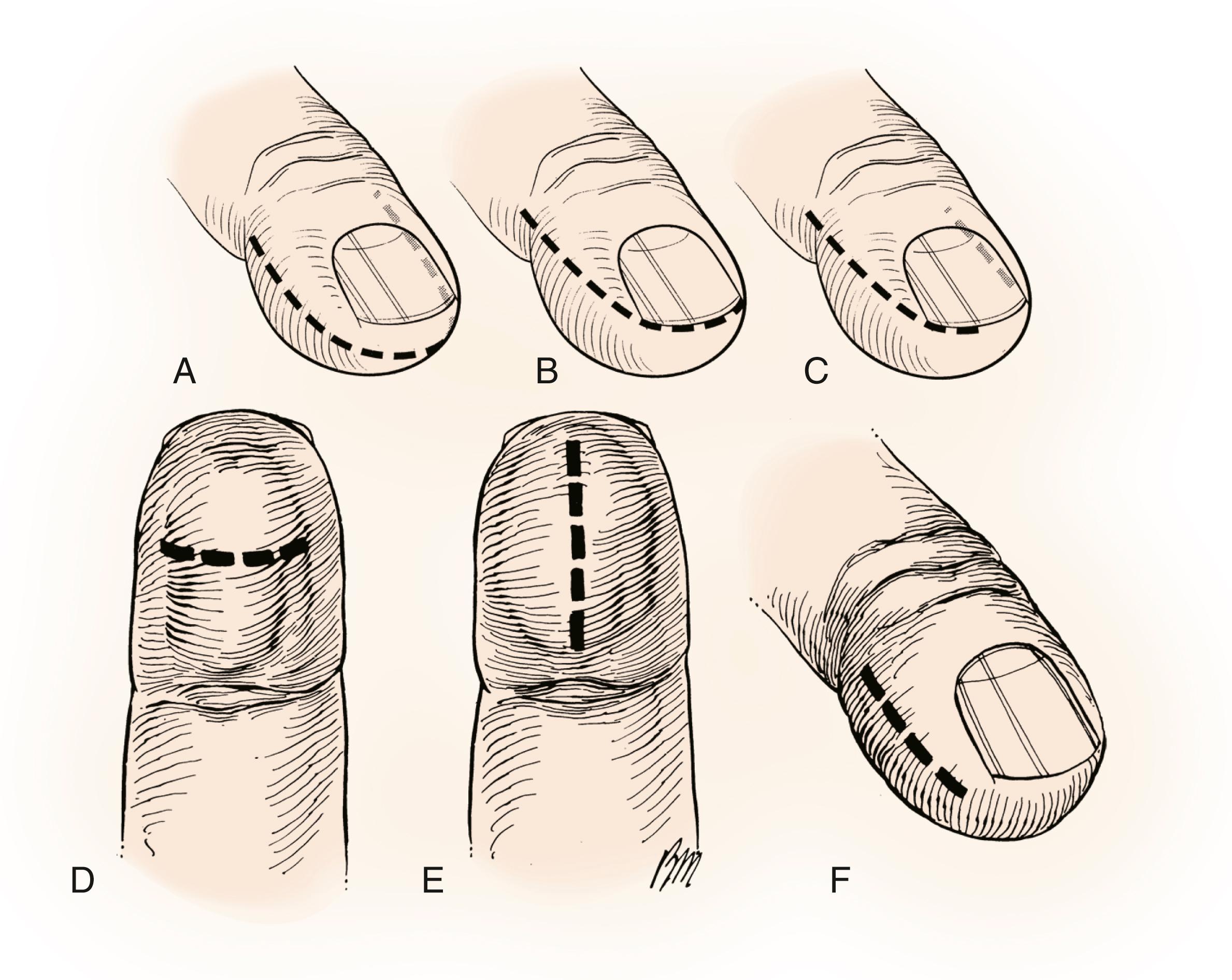
Nonsurgical management is reserved only for the very early presentation of an acute felon. Typically, the felon is a rapidly developing process that presents with a tensely swollen and exquisitely tender pulp. This requires surgical decompression whether fluctuance is present or not. We prefer to perform surgery under digital block anesthetic with sedation. A forearm tourniquet is used. The extremity is exsanguinated by elevation. The surgical incision is made longitudinally. When the point of maximal tenderness is located in the middle of the pulp or when a sinus is present along the volar surface, we use a longitudinal volar incision. When the point of tenderness is on the side of the pulp, we use a unilateral longitudinal incision. Although the incision is preferably placed on the side opposite the pinching surface, the incision should always be placed on the side of maximal tenderness. When possible, the incision is made on the ulnar side of the second to fourth digits and on the radial side in the thumb and small finger. The incision is started dorsal to and 0.5 cm distal to the DIP joint flexion crease. It is continued distally in line with the volar margin of the distal phalanx, but it does not cross over the fingertip. The incision is deepened along a plane just volar to the palmar cortex of the phalanx until the abscess is entered. The opening in the cavity is enlarged until adequate evacuation is achieved.
All involved septa should be opened, and a wound culture is taken. The flexor tendon sheath should not be violated, unless there are signs of tendon sheath involvement, to avoid an iatrogenic tendon sheath infection. The distal phalanx must be examined with a probe. A rough or softened surface indicates bone involvement, which requires debridement of the softened or necrotic bone. After thorough debridement and irrigation, the wound is kept open with a thin gauze wick, and a sterile dressing is applied. The first dressing change is 12 and 24 hours after the initial procedure.
Become a Clinical Tree membership for Full access and enjoy Unlimited articles
If you are a member. Log in here